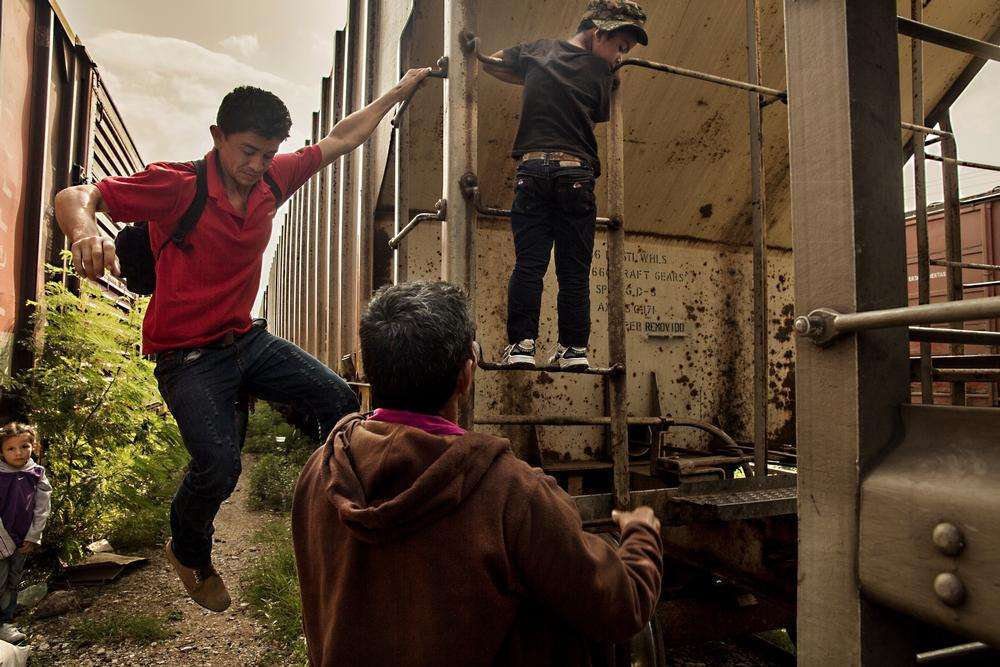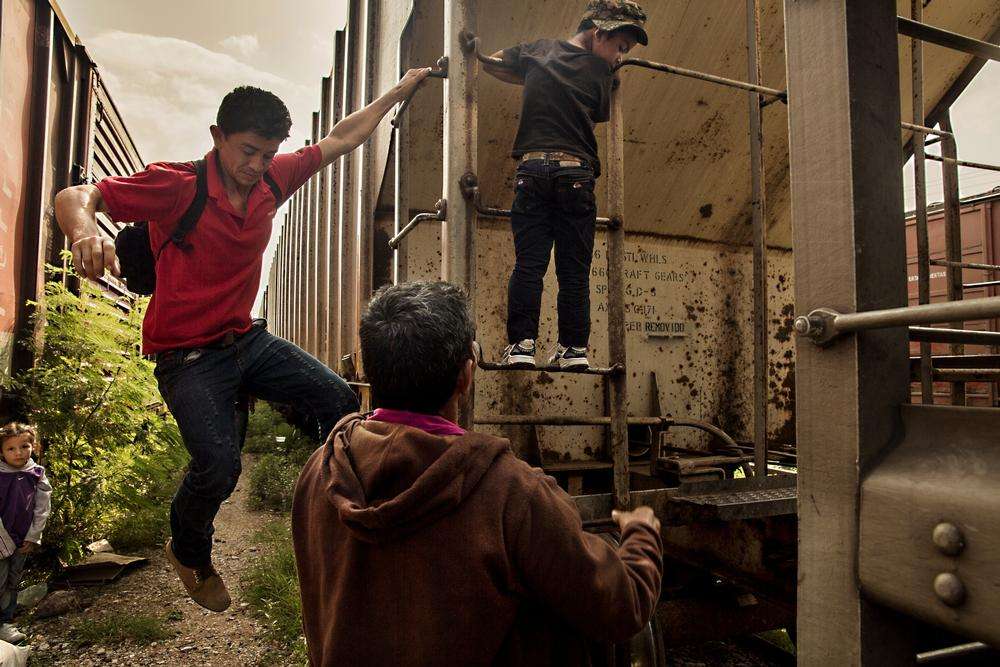Guatemalan migrant Byron Solares's life is about to change. He is aboard “the Beast,” the Mexican cargo train ridden by tens of thousands of Central American migrants trying to reach the United States every year. Chased by a gang of criminals who are trying to rob him, Byron jumps from car to car along the moving train, seeking a nook or cranny in its metallic shell where he can take cover. As he runs along the roof of a car, the train shudders. Byron loses his balance, falls, and blacks out.
"When I Saw Myself, I Didn't Want to Live . . . "
“I broke both my shin and calf bone in the fall,” says Byron. “It was in 2009. Since it was Christmas Day, there was no doctor on duty.” After his belongings were taken from him, the Guatemalan was taken back to his country. The memories of that winter are hazy; he was in a coma for 20 days. And waking up was harsh. “When I saw myself I didn’t want to live. I had surgery on my stomach, my arms . . . I lost my leg because it took them a while to operate and it had already got infected. The doctor told me that my leg needed to be amputated, otherwise I could die.”
Migrants in Mexico
Almost five years later, Byron, now 34, is on the road again. Undeterred by his physical impairments, he crossed the Guatemalan border and reached Tapachula, in Mexico. He is staying at the Jesús el Buen Pastor albergue (shelter). “This time I am planning to stay here in Mexico,” he says, seated in a wheelchair. “I am hoping to walk again, but with something that is not a part of my body.” Soon he will receive a prosthetic leg.
An estimated 300,000 people enter Mexico each year with the aim of reaching the US, though some stay on in Mexico. Most are from Honduras, El Salvador, and Guatemala. A lack of official figures makes it difficult to assess the scale of this mass movement of people and the extent of their humanitarian needs. Their means of travel is often hazardous, especially for those riding “the Beast.” Migrants clamber onto the train’s roof, or squeeze themselves between the wagons, exposed to the elements and to attacks by criminal gangs.
Women and Children are Most Vulnerable
While the typical profile of a migrant en route to the US is a Central American man aged 18 to 25, increasingly women, families, and unaccompanied children are making the journey. These are the most vulnerable groups, who have to overcome all manner of dangers just to survive. Along the route, they risk falling victim to human trafficking, kidnapping, assault, robbery, or extortion by security forces or criminal gangs. Some women are so certain that they will be victims of sexual violence that they have contraceptive injections before their departure.
A young Honduran woman is sitting beside the railway tracks in Lechería, central Mexico. Her name is Raquel Julieth Hernandes and she is 19 years old. In the shade of a tree, she recalls how she decided to leave her son with her mother and head for the US.
She stopped in Tapachula, Mexico, near the Guatemalan border, where she worked for a while as a food seller. But it was not long before all the money she had earned was brutally stolen from her. “They mugged me, they hit me,” she recalls. “I was seriously hurt for 15 days.” A group of Hondurans found her and helped her. “I couldn’t even get up. I had fever for almost 15 days. Now she's exhausted from the several weeks it took her to get from Tapachula to Lechería. She can’t decide whether to stop in Lechería or continue to the US border.
Reaching the US Border
It is not unusual in Mexico to see women, teenagers, and even children hopping freight trains. They stay in albergues or try to rest for a few hours beside the tracks before continuing their journey. Doctors Without Borders/Médecins Sans Frontières (MSF) teams are trying to provide medical assistance through mobile clinics, but this can be a challenge. “The migrant is clear about one thing: he wants to reach the border,” says Juan Manuel López, an MSF logistician. “If the train comes, the migrant tries to jump on it, at a run.”
The number of children en route to the US keeps on growing. Nine percent of the patients treated by MSF in south and central Mexico are minors. “Kids typically come with their families—normally they are not alone,” says MSF psychologist Miguel Gil. “They live it in another way, they have a clearer perspective of time than adults, and they learn the route and the places by heart.”
Of course, this doesn’t mean that they don’t experience suffering. Child or adult, no one is spared the anguish of the journey. “Only the people jumping the train know that anguish, the energy felt up there,” says Gil. “Just the noise of the wheels on the rail gets you nervous. Some trains don’t stop for more than 24 hours, traveling in high temperatures or through torrential rain. The migrants are emotionally and physically drained.”
Violence and a Lack of Legal Protection
The growing number of children making the journey calls into question regional migration policies, which are particularly cruel with regard to the most vulnerable sections of society, especially because the influx of migrants keeps changing and they don’t exactly match the classic pattern of economic migration. The violence in Central America, mainly at the hands of maras (local gangs) that carry out extortion and threats, is forcing thousands into exile.
For example, 42 percent of the Salvadoran migrants treated by MSF and 32 percent of Hondurans said violence-related issues played a decisive role in their decision to leave.[i] Even though there are mechanisms in place allowing them to seek asylum in both Mexico and the US, this population is often treated as regular migrants would be, while the process to obtain refugee status is lengthy and doesn’t cover the on-the-ground needs of the Central Americans.
Another change that would make life easier for the migrants is speeding up the process to get “humanitarian visas” in Mexico. Those applying for these visas have usually been victims of violence en route, a phenomenon on the rise.
Photo Story: Migrants' Journey Through Mexico To the US
The stoicism with which the migrants look at violent episodes illustrates the level of insecurity they are facing. Asked how they had felt before their departure, 26 percent of MSF patients thought they would definitely be victims of violence, compared to 45 percent who acknowledged this as a possibility and 29 percent who ruled it out. The reality is that six out of ten migrants treated by MSF teams in south and central Mexico said they suffered violent incidents on their journeys. And it is worth remembering that this is only the first step on the long route to the US.
The psychological impact of violence experienced on the journey can’t be overstated. Every move is a risk. “The train was coming with many [cars] and suddenly stopped,” says Yenny Guardado, a 26-year-old Salvadoran. “My husband told me: ‘That’s not good.’ I could hear motorbikes. Then the thieves boarded the train and the women started screaming. We put our backpacks on. I was nervous, I was trembling. Some of the people on the train were banging their machetes, trying to scare the thieves away. But in the end nothing happened to us and the train went on.”
Yenny can’t take the stress any longer. She is in Ixtepec, one of the main stops on the Pacific route, and she doesn’t want to go on. The attack on the train and the stories told by the women she met on the way have convinced her to return home. She has asked to be taken back to her country: in a few hours the Grupo Beta, a group that protects migrants, will come to the Padre Solalinde albergue to pick her up and initiate the process of repatriation.
“I never thought that the route was going to be like this,” says Yenny, who left her two daughters behind in El Salvador. “There are women who have the same objectives, to reach the US, but only a few decide to go on. Just imagine—you are thrilled, you have a dream, but then the route can take your life away. It isn’t worth leaving your kids alone just because you are chasing a dream.” She plans to return to her daughters while her husband continues the journey alone.
The Dictatorship of the Train
For those on the journey, the railway line is like a river allowing daily life to bloom around it. Yenny knows it. The train, with its departures and arrivals, rules time: it keeps the travelers awake, forces them into endless waits; it derails, gets delayed, runs full steam ahead and allows no one to sleep on its back. It is difficult to take a nap. Everyone pays attention to the train’s majestic progress: around the wagons and the tracks, rumors and legends spread about the latest tragedies that have happened on board. Fear, violence, and physical and mental upheaval form an emotional web trapping anyone who dares to approach.
José Armando Pineda, a 62-year-old Salvadoran, is anxiously waiting to board “the Beast” in Tierra Blanca, Veracruz. “A 16-year-old boy who was coming with us fell down and the train cut his foot off,” he says. “Now he will get a prosthetic foot.”
The rush of a freight train going in the other direction momentarily interrupts his words. Everyone raises their eyes to follow its path. When it moves away, José Armando says, “I like it, it’s beautiful . . . [but the trip is] not an easy one, it’s very risky.” He shades his eyes with one hand as he looks out at the tracks stretching off to the horizon. “I just took a shower, I feel more agile,” he says. “I am ready to jump.”
MSF has been running projects treating migrants in Mexico since 2011, focusing on a humanitarian response to the violence endured by Central Americans on their journey. In Ixtepec, MSF runs a clinic and delivers psychological care. There are also MSF teams working in Tierra Blanca and Huehuetoca, providing mental health services, and in Lechería and Bojay providing basic health care through mobile clinics. In 2013, the teams conducted 11,323 regular and mental health consultations. Of these, 1,389 migrants were treated for trauma and 837 attended individual psychological sessions.
[i] Survey of 396 MSF patients conducted between July 2013 and February 2014. The patients were treated in central and southern Mexico, so the conclusions of the study cannot be extrapolated to the whole migrant population or the situation on the border with the United States.
“The train was coming with many wagons and suddenly stopped. My husband told me, ‘That’s not good.’ I could hear motorbikes. Then the thieves boarded the train and the women started screaming."
YENNY GUARDADO





